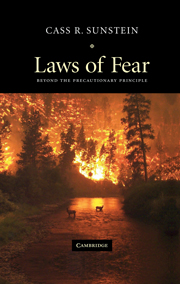5 - Reconstructing the Precautionary Principle — and Managing Fear
Published online by Cambridge University Press: 05 September 2012
Summary
I have been sharply critical of the Precautionary Principle, but no one doubts that it makes sense to take precautions. An appreciation of the salutary goals of the Precautionary Principle paves the way toward a reconstruction of the central idea, one that takes seriously the concerns of those who favor it. The reconstruction occurs along three dimensions. The first involves catastrophic risks. The second involves irreversible harms. The third involves margins of safety for risks that, while not potentially catastrophic, pose distinctive reasons for concern. After discussing the resulting principles, I explore how government might deal with both excessive and insufficient public fear.
CATASTROPHE
When citizens face catastrophic risks to which probabilities cannot be assigned, it makes sense for them to adopt an Anti-Catastrophe Principle. If regulators are operating under conditions of uncertainty, they might well do best to follow maximin, identifying the worst-case scenarios and choosing the approach that eliminates the worst of these. It follows that if aggressive measures are justified to reduce the risks associated with global warming, one reason is that those risks are potentially catastrophic and existing science does not enable us to assign probabilities to the worst-case scenarios. Maximin is an appealing decision rule whenever uncertainty is present, but in the regulatory context, it is particularly important for extremely bad outcomes.
To understand these claims, we need to back up a bit and to investigate maximin in more detail. Does it generally make sense to eliminate the worst-case scenario?
Information
- Type
- Chapter
- Information
- Laws of FearBeyond the Precautionary Principle, pp. 109 - 128Publisher: Cambridge University PressPrint publication year: 2005
Accessibility standard: Unknown
Why this information is here
This section outlines the accessibility features of this content - including support for screen readers, full keyboard navigation and high-contrast display options. This may not be relevant for you.Accessibility Information
- 13
- Cited by
